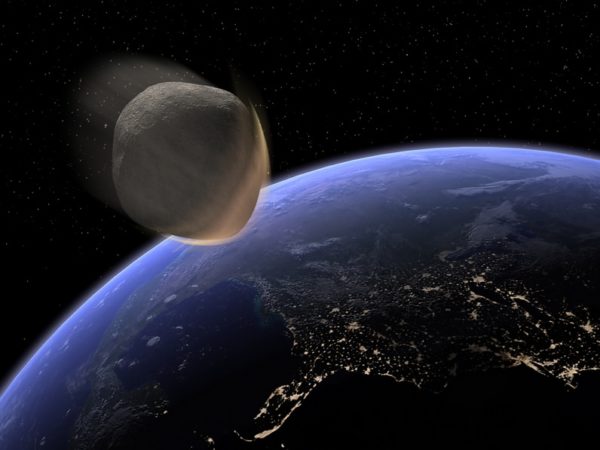
 A surprise asteroid about the same size as the Chelyabinsk meteor of 2013 just barely missed crashing into the Earth, reminding the world’s astronomers that we still have a long way to go in terms of detecting the more deadly of these space missiles.
A surprise asteroid about the same size as the Chelyabinsk meteor of 2013 just barely missed crashing into the Earth, reminding the world’s astronomers that we still have a long way to go in terms of detecting the more deadly of these space missiles.
The asteroid named 2017 AG13, estimated to be between 16 and 34 metres in diameter, flew by the Earth at 7:50 am EST on Monday, according to data from NASA’s Jet Propulsion Laboratory (JPL). Remarkably, the hitherto undetected space rock came hurtling by at a distance roughly half that of the moon’s orbit, just 190,000 kilometres away. A similar-sized asteroid exploded over the Russian city of Chelyabinsk on February 15, 2013, injuring 1,000 people. That blast had the power of 30 atomic bombs but at a distance of 16 kilometres up, the damage was limited.
AG13 was only spotted on Saturday as it quickly made its approach by the University of Arizona-based Catalina Sky Survey. “This is moving very quickly, very nearby to us,” said astronomer Eric Edelman with Slooh, during a live broadcast of the flyby on Monday morning. Edelman said that AG13 has a particularly elliptical orbit and that over time it crosses the paths of both Venus and Earth, travelling at a speed of 16 kilometres per second.
While the event was concerning, close shaves with asteroids are in reality not that rare – a reported 35 more Near-Earth Objects (NEOs) are scheduled to come closer than the moon to Earth during the month of January alone. Only last August, a 15 to 30 metre-wide NEO came scarily close to hitting us and was only detected hours before its flyby.
But the majority of major NEOs – ones which could prove cataclysmic if they actually made impact with the Earth – have been identified. NASA’s NEO Observations Program, responsible for finding and tracking the larger of the NEOs, stated in October of this past year that over 15,000 NEOs have now been identified, with about 30 more being added every week. “The rising rate of discovery is due to dedicated NEO surveys and upgraded telescopes coming online in recent years,” said NASA’s NEO Observations Program Manager Kelly Fast. “But while we’re making great progress, we still have a long way to go.”
Currently, space agencies around the world are funding asteroid-based missions, aimed at learning more about their composition and, importantly, how we might go about rerouting a potentially hazardous one. NASA’s OSIRIS-REx space probe is presently on its way to the asteroid Bennu, aiming to bring back to Earth samples from the space rock, while the space agency’s Discovery Program has just announced a pair of missions to asteroids, set to launch in the early 2020s.
Both missions have significant contributions from Canadian-based research, as OSIRIS-REx is equipped with a laser altimeter to map the surface of Bennu, provided by the Canadian Space Agency, and the new Discovery mission to the asteroid 16 Psyche will run on a spacecraft platform made by Canadian-based communications company, MacDonald, Dettwiler and Associates.
Scientists say that the Earth is, in fact, bombarded with space rocks and debris on a regular basis, including about 100 tonnes of material in the form of tiny grains of dust and sand that impact and add to the Earth’s mass every day.
Leave a Reply
You must be logged in to post a comment.



 Share
Share Tweet
Tweet Share
Share




Comment